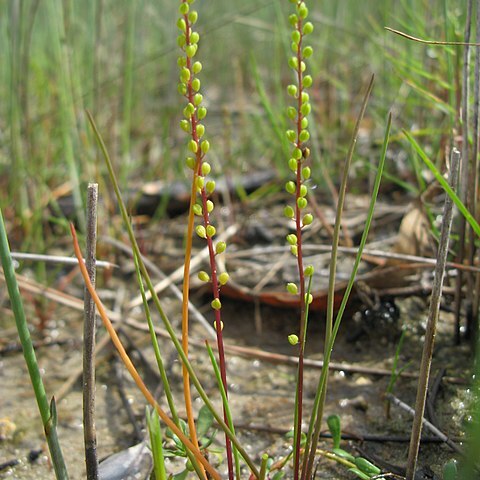Plants with fibrous strands of old leaves at base, 6--35 cm. Leaves erect from sheath, mostly longer than scapes, 4--35 cm; sheath 1.1--7.5 cm 0.7--1 mm, ligule not hoodlike, unlobed; blade 0.2--5 mm wide, apex round-acute. Inflorescences: scape green to brown, mostly exceeded by leaves, 4.5--21.5 cm 0.3--1.6 mm; racemes 0.6--20.3 0.4--1.3 cm; pedicels 0.4--2.1 0.1--0.3 mm. Flowers: tepals oval to elliptic, 0.6--1 0.8--0.9 mm, apex obtuse; pistils 6, 3 fertile, 3 sterile. Fruits: fruiting receptacle with wings; schizocarps globose to broader than long, 1--2 1.5--2.3 mm; mericarps obovate, strongly 3-keeled, 1--1.5 0.5--0.9 mm, beak reflexed, ca. 0.2 mm. Chromosome number unavailableunknown.
Perennials, variable in size, 5-50 cm high, forming long, woody stolons. Roots firm and coarse interspersed with thin young matted feeding roots. Rhizome woody, sparsely covered with fibres. Leaves arranged in a compact fan-shaped manner with the sheaths broad, distinctly ligulate, lamina cylindrical, 5-30 cm long, succulent, green, apex obtuse. Inflorescence ultimately overtopping the leaves, the flowers arranged in dense spiral whorls, pedicels arcuate, decurrent, very short at first, up to 3 mm long in fruit. Flowers small, segments 1 mm long; carpels 6, the 76 mmner fertile alternating with the 3 sterile outer. Follicles globose, 2 mm in diam., 3-costate, compressed, shortly stipitate, apiculate.
Perennial herb, helophyte, 0.10-0.32 m high; rhizome woody, stoloniferous, sparsely covered with fibres. Leaves distichous, succulent, linear, almost terete, green. Inflorescence with flowers arranged in dense spiral whorls; pedicels arcuate, decurrent; perianth segments 1 mm long. Flowering time Sept.-May. Follicles globose, 3-ribbed, compressed, apiculate, with 3 inner fertile, dorsally keeled carpels alternating with 3 outer sterile ones.
Habitally like no. 2 [Triglochin palustris L.]; lvs often as long as the scapes; tep and stamens each 3; ovaries 3; fr-cluster subglobose, 3 mm, the separated carpels rounded at both ends, the axis broadly 3-winged. Salt-marshes and wet coastal sands; tropical Amer., n. locally to Del. and Md.; also Old World. May–Sept.
Tufted, rhizomatous perennial, 5-50 cm. Leaves subdistichous, terete. Flowers in dense spiral whorls. Fruits globose, 2 mm long.
Like T. elongata but flowers in dense spiral whorls and fruit globose, 2 mm long.

